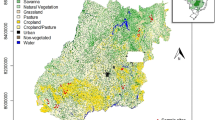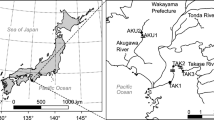Abstract
Vegetated habitats in estuaries may provide a structural refuge and food supply in the same place, but benefits are also derived where a productive food source and suitable habitat are adjacent to each other. Quantifying these relationships is fundamental to understanding the structural and functional characteristics of estuarine ecosystems and for informing management actions. Effective juvenile habitat (habitat that contributes greater-than-average numbers of recruits to the adult population), recruitment patterns and trophic relationships were studied for Eastern King Prawn (Penaeus plebejus) in the lower Clarence River estuary, New South Wales, between 2014 and 2016. Effective juvenile habitat was identified in both the north arm and main river channel of the estuary, and these areas also supported a higher abundance of juvenile prawns. There was minimal recruitment to the southern channels of the estuary, possibly due to reduced connectivity with the incoming tide arising from a rock wall. Trophic relationships in parts of the lower estuary were evaluated using stable isotopes, and saltmarsh grass (Sporobolus virginicus) was the dominant primary producer supporting juvenile Eastern King Prawn productivity across the area. Mangroves were of minimal importance, and seagrass cover was minimal in the area studied. The patterns observed indicate that nursery function of different areas within the lower estuary is a product of connectivity, recruitment and nutrition derived from primary productivity of vascular plants. Habitats within the lower Clarence River estuary have seen substantial degradation over decadal time scales, and the implications of our findings for targeting future habitat repair are discussed.







Similar content being viewed by others
References
Abrantes, K., and M. Sheaves. 2008. Incorporation of terrestrial wetland material into aquatic food webs in a tropical estuarine wetland. Estuarine, Coastal and Shelf Science 80: 401–412.
Ahrens, R.N.M., C.J. Walters, and V. Christensen. 2012. Foraging arena theory. Fish and Fisheries 13: 41–59.
Beck, M.W., K.L. Heck Jr., K.W. Able, D.L. Childers, D.B. Eggleston, B.M. Gillanders, B. Halpern, C.G. Hays, K. Hoshino, T.J. Minello, R.J. Orth, P.F. Sheridan, and M.P. Weinstein. 2001. The identification, conservation, and management of estuarine and marine nurseries for fish and invertebrates. Bioscience 51: 633–641.
Becker, A., and M.D. Taylor. 2017. Nocturnal sampling reveals usage patterns of intertidal marsh and sub-tidal creeks by penaeid shrimp and other nekton in south-eastern Australia. Marine and Freshwater Research 68: 780–787.
Becker, A., P.D. Cowley, and A.K. Whitfield. 2010. Use of remote underwater video to record littoral habitat use by fish within a temporarily closed South African estuary. Journal of Experimental Marine Biology and Ecology 391: 161–168.
Blanco-Martínez, Z., and R. Pérez-Castañeda. 2017. Does the relative value of submerged aquatic vegetation for penaeid shrimps vary with proximity to a tidal inlet? Preliminary evidence from a subtropical coastal lagoon. Marine and Freshwater Research 68: 581–591.
Boesch, D.F., and R.E. Turner. 1984. Dependence of fishery species on salt marshes: the role of food and refuge. Estuaries 7: 460–468.
Boys, C.A., and R.J. Williams. 2012. Succession of fish and crustacean assemblages following reinstatement of tidal flow in a temperate coastal wetland. Ecological Engineering 49: 221–232.
Boys, C.A., F.J. Kroon, T.M. Glasby, and K. Wilkinson. 2012. Improved fish and crustacean passage in tidal creeks following floodgate remediation. Journal of Applied Ecology 49: 223–233.
Connolly, R.M., and N.J. Waltham. 2015. Spatial analysis of carbon isotopes reveals seagrass contribution to fishery food web. Ecosphere 6: 1–12.
Connolly, R.M., D. Gorman, and M.A. Guest. 2005. Movement of carbon among estuarine habitats and its assimilation by invertebrates. Oecologia 144: 684–691.
Costanza, R., R. d'Arge, R. de Groot, S. Farber, M. Grasso, B. Hannon, K. Limburg, S. Naeem, R.V. O'Neill, J. Paruelo, R.G. Raskin, P. Sutton, and M. van den Belt. 1997. The value of the world's ecosystem services and natural capital. Nature 387: 253–260.
Creighton, C., P.I. Boon, J.D. Brookes, and M. Sheaves. 2015. Repairing Australia's estuaries for improved fisheries production—what benefits, at what cost? Marine and Freshwater Research 66: 493–507.
Dahlgren, C.P., G.T. Kellison, A.J. Adams, B.M. Gillanders, M.S. Kendall, C.A. Layman, J.A. Ley, I. Nagelkerken, and J.E. Serafy. 2006. Marine nurseries and effective juvenile habitats: concepts and applications. Marine Ecology Progress Series 312: 291–295.
Dakin, W.J. 1938. The habits and life-history of a penaeid prawn (Penaeus plebejus). Proceedings of the Zoological Society of London A108: 163–181.
Dall, W., B. Hill, P. Rothlisberg, and D. Sharples. 1990. Life histories. In The biology of the Penaeidae, 283–313. London: Academic Press.
Elliott, M., A.K. Whitfield, I.C. Potter, S.J.M. Blaber, D.P. Cyrus, F.G. Nordlie, and T.D. Harrison. 2007. The guild approach to categorizing estuarine fish assemblages: a global review. Fish and Fisheries 8: 241–268.
Fry, B. 2006. Stable isotope ecology. New York: Springer.
Fry, B., and K. Ewel. 2003. Using stable isotopes in mangrove fisheries research—a review and outlook. Isotopes in Environmental and Health Studies 39: 191–196.
Gaston, T.F., T.A. Schlacher, and R.M. Connolly. 2006. Flood discharges of a small river into open coastal waters: plume traits and material fate. Estuarine, Coastal and Shelf Science 69: 4–9.
Guest, M.A., and R.M. Connolly. 2004. Fine-scale movement and assimilation of carbon in saltmarsh and mangrove habitat by resident animals. Aquatic Ecology 38: 599–609.
Guest, M.A., R.M. Connolly, S.Y. Lee, N.R. Loneragan, and M.J. Breitfuss. 2006. Mechanism for the small-scale movement of carbon among estuarine habitats: organic matter transfer not crab movement. Oecologia 148: 88–96.
Haas, H.L., K.A. Rose, B. Fry, T.J. Minello, and L.P. Rozas. 2004. Brown shrimp on the edge: linking habitat to survival using an individual-based simulation model. Ecological Applications 14: 1232–1247.
Layman, C.A. 2007. What can stable isotope ratios reveal about mangroves as fish habitat? Bulletin of Marine Science 80: 513–527.
Lenanton, R.C.J., and I.C. Potter. 1987. Contribution of estuaries to commercial fisheries in temperate Western Australia and the concept of estuarine dependence. Estuaries 10: 28–35.
Mazumder, D., and N. Saintilan. 2010. Mangrove leaves are not an important source of dietary carbon and nitrogen for crabs in temperate Australian mangroves. Wetlands 30: 375–380.
Melville, A.J., and R.M. Connolly. 2003. Spatial analysis of stable isotope data to determine primary sources of nutrition for fish. Oecologia 136: 499–507.
Melville, A.J., and R.M. Connolly. 2005. Food webs supporting fish over subtropical mudflats are based on transported organic matter not in situ microalgae. Marine Biology 148: 363–371.
Minello, T.J., and P.A. Caldwell. 2006. Analysis of the potential fishery value of the ‘Demonstration Marsh’ on Atkinson Island in Galveston Bay, Texas, 20. Galveston, Texas: National Marine Fisheries Service, Southeast Fisheries Science Center.
Minello, T.J., K.W. Able, M.P. Weinstein, and C.G. Hays. 2003. Salt marshes as nurseries for nekton: testing hypotheses on density, growth and survival through meta-analysis. Marine Ecology Progress Series 246: 39–59.
Montgomery, S.S. 1990. Movements of juvenile eastern king prawns, Penaeus plebejus, and identification of stock along the east-coast of Australia. Fisheries Research 9: 189–208.
Moriarty, D.J.W. 1977. Quantification of carbon, nitrogen and bacterial biomass in food of some penaeid prawns. Australian Journal of Marine and Freshwater Research 28: 113–118.
Nagelkerken, I., M. Sheaves, R. Baker, and R.M. Connolly. 2015. The seascape nursery: a novel spatial approach to identify and manage nurseries for coastal marine fauna. Fish and Fisheries 16: 362–371.
Ochwada, F., N.R. Loneragan, C.A. Gray, I.M. Suthers, and M.D. Taylor. 2009. Complexity affects habitat preference and predation mortality in postlarval Penaeus plebejus: implications for stock enhancement. Marine Ecology Progress Series 380: 161–171.
Peterson, B.J., and B. Fry. 1987. Stable isotopes in ecosystem studies. Annual Review of Ecology and Systematics 18: 293–320.
Phillips, D.L., and J.W. Gregg. 2003. Source partitioning using stable isotopes: coping with too many sources. Oecologia 136: 261–269.
Racek, A.A. 1959. Prawn investigations in eastern Australia. State Fisheries Research Bulletin 6: 1–57.
Roy, P.S., R.J. Williams, A.R. Jones, I. Yassini, P.J. Gibbs, B. Coates, R.J. West, P.R. Scanes, J.P. Hudson, and S. Nichol. 2001. Structure and function of south-east Australian estuaries. Estuarine, Coastal and Shelf Science 53: 351–384.
Ruello, N.V. 1975. Geographical distribution, growth and breeding migration of eastern Australian King Prawn Penaeus plebejus Hess. Australian Journal of Marine and Freshwater Research 26: 343–354.
Saintilan, N., and L. Wen. 2012. Environmental predictors of estuarine fish landings along a temperate coastline. Estuarine, Coastal and Shelf Science 113: 221–230.
Sheaves, M. 2017. How many fish use mangroves? The 75% rule an ill-defined and poorly validated concept. Fish and Fisheries. https://doi.org/10.1111/faf.12213.
Sheaves, M., K. Abrantes, and R. Johnston. 2007. Nursery ground value of an endangered wetland to juvenile shrimps. Wetlands Ecology and Management 15: 311–327.
Smith, J.A., D. Mazumder, I.M. Suthers, and M.D. Taylor. 2013. To fit or not to fit: Evaluating stable isotope mixing models using simulated mixing polygons. Methods in Ecology and Evolution 4: 612–618.
Suthers, I.M. 1984. Functional morphology of the mouthparts and gastric mill in Penaeus plebejus Hess (Decapoda, Penaeidea). Australian Journal of Marine and Freshwater Research 35: 785–792.
Taylor, M.D. 2016. Identifying and understanding nursery habitats for exploited penaeid shrimp in NSW estuaries. In 25th Annual NSW Coastal Conference, 9–11th November, 2016, 1–8. Coffs Harbour. http://www.coastalconference.com/2016/papers2016/Matt%20Taylor.pdf.
Taylor, M.D., J.A. Smith, C.A. Boys, and H. Whitney. 2016. A rapid approach to evaluate putative nursery sites for penaeid prawns. Journal of Sea Research 114: 26–31.
Taylor, M.D., B. Fry, A. Becker, and N.A. Moltschaniwskyj. 2017. Recruitment and connectivity influence the role of seagrass as a penaeid nursery habitat in a wave dominated estuary. Science of the Total Environment 584–585: 622–630.
Turner, R.E. 1977. Intertidal vegetation and commercial yields of penaeid shrimp. Transactions of the American Fisheries Society 106: 411–416.
Vander Zanden, M.J., and J.B. Rasmussen. 2001. Variation in d15N and d13C trophic fractionation: Implications for aquatic food web studies. Limnology and Oceanography 46: 2061–2066.
Zimmerman, R.J., and T.J. Minello. 1984. Densities of Penaeus aztecus, Penaeus setiferus, and other natant macrofauna in a Texas salt marsh. Estuaries 7: 421–433.
Zimmerman, R.J., T.J. Minello, and G. Zamora Jr. 1984. Selection of vegetated habitat by Penaeus aztecus in a Galveston Bay salt marsh. Fishery Bulletin 82: 325–336.
Acknowledgements
We thank B. Fry, E. Mitchell, I. Thiebaud, S. Walsh, H. Whitney, T. Ryan, A. Fowler, A. Russell, V. Raoult, D. Coulthard and J. McLeod for assistance collecting samples throughout this project and K. Russel and C. Copeland for guidance during the execution of the project. This project was supported by the Fisheries Research and Development Corporation on behalf of the Australian Government (2013/006; project partners Origin Energy, Newcastle Ports Corporation, Hunter Water and Local Land Services). Funding bodies and project partners had no role in the design, data collection, analysis or interpretation of data. Prawn sampling was carried out under permit P01/0059(A)-2.0 and Animal Research Authority NSW DPI 13/08.
Author information
Authors and Affiliations
Corresponding author
Additional information
Communicated by Judy Grassle
Rights and permissions
About this article
Cite this article
Taylor, M.D., Becker, A., Moltschaniwskyj, N.A. et al. Direct and Indirect Interactions Between Lower Estuarine Mangrove and Saltmarsh Habitats and a Commercially Important Penaeid Shrimp. Estuaries and Coasts 41, 815–826 (2018). https://doi.org/10.1007/s12237-017-0326-y
Received:
Revised:
Accepted:
Published:
Issue Date:
DOI: https://doi.org/10.1007/s12237-017-0326-y




